
French postcard by Editions du Globe, Paris, no. 41. Photo: Sam Lévin.
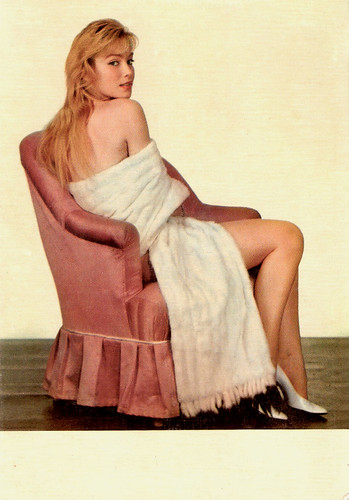
French postcard by Editions P.I., Paris, no. 1027. Photo: Sam Lévin.

Big vintage card. Photo: Sam Lévin.
Sexy schoolgirls
Estella Blain was born as Micheline Estellat in Paris in 1930.
In 1953 she married the actor Gérard Blain. The following year they appeared together in the film Les fruits sauvages/Wild Fruit (Hervé Bromberger, 1954). She played a young girl who accidentally kills her alcoholic father and with a group of rebellious youngsters, she finds refuge in an old, deserted village. Estella and Gérard divorced in 1956, but she kept his name.
She played one of the sexy schoolgirls in Les collégiennes/The Twilight Girls (André Hunebelle, 1957) with Agnès Laurent and Catherine Deneuve in her first, small film role. Blain worked again with director Hervé Bromberger at La bonne tisane/Good Medicine (Hervé Bromberger, 1958) in which she played a young idealistic nurse on her first tour of duty, who is horrified by the carelessness of her colleagues and the doctors.
She was quite busy during this period. In the routine spy thriller Le fauve est lâché/The Beast Is Loose (Maurice Labro, 1959) she starred opposite tough guy Lino Ventura. In Les dragueurs/The Chasers (Jean-Pierre Mocky, 1959), she was one of the girls chased by Jacques Charrier and Charles Aznavour.
In the thriller Des femmes disparaissent/The Road to Shame (Edouard Molinaro, 1959) she played a victim of the white-slave trade who is saved by her car mechanic fiance, played by Robert Hossein. At Films de France, James Travers reviews: “an all too obvious imitation of the American gangster movie, although Molinaro does manage to evoke the essence of classic film noir very effectively in some sequences. The problem with the film is that it is too much of a pastiche, with very little substance to it – no real characterisation, a threadbare plot, and interminable, badly choreographed, fight scenes. On the plus side, Art Blakey’s marvellous jazz score gives the film a touch of stylish modernity, an innovation which thriller directors of the time were quick to emulate”.
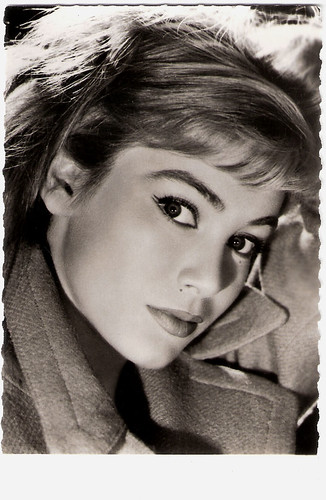
French postcard by Editions P.I., Paris, no. 977. Offered by Les Carbones Korès Carboplane. Photo: Sam Lévin.

French postcard by Editions du Globe, Paris, no. 703. Photo: Studio Harcourt.
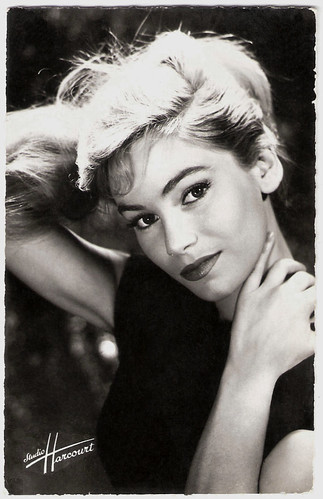
French postcard by Editions du Globe, Paris, no. 802. Photo: Studio Harcourt.
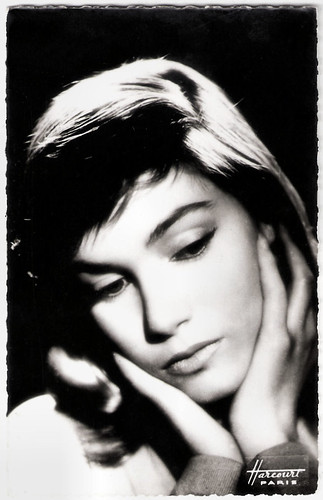
French postcard. Photo Studio Harcourt, Paris.
A zombie-like killing machine
In 1959 Estella Blain also had a son, Michel Blain-Estellat, who later became an actor and director. For him, she wrote the series Un enfant nommé Michel/A child named Michael in which he performed the title role. During the 1960s, her film career went downhill. She played in such mediocre international productions as the Italian adventure film I pirati della costa/Pirates of the Coast (Domenico Paolella, 1960) starring Lex Barker, and the German operetta Im weißen Rößl/The White Horse Inn (Werner Jacobs, 1960) starring Peter Alexander.
Her best-known role was a supporting part as the poisonous Madame De Montespan in Angélique et le roy/Angelique and the King (Bernard Borderie, 1966), the third in the series of five films adapted from the stories by Anne and Serge Golon featuring Michèle Mercier.
As a singer, she had two melancholic hit songs in 1965, Solitude (Dim Dam Dom) and Il ne faut pas (It is not necessary), which she had both written and composed herself. Blain also played a singer in the dark, surrealistic horror film Miss Muerte/The Diabolical Dr. Z (Jesus Franco, 1966). Miss Muerte is an exotic dancer who becomes a zombie-like killing machine, that lures and kills victims with razor-sharp and poisoned fingernails while clad in a skull mask and a revealing bodysuit.
At IMDb, reviewer Jens Kofoed-Pihl names it “one of the best, creepiest and most stylish from the Godfather of Eurosleaze” (cult filmmaker Jesus Franco) and “a masterpiece of the macabre!” Robert Pirsching at AllMovie calls it “One of Franco's most entertaining films”.
However, at the end of the decade, Blain was only incidentally seen on TV and in the theatre, although she had a small part in the film comedy A Flea in Her Ear (Jacques Charon, 1968) starring Rex Harrison. Her last film role was in the dark satire Le mouton enragé/Love at the Top (Michel Deville, 1974) starring Jean-Louis Trintignant and Romy Schneider. Estella Blain died on 1 January 1982 in her home in Port-Vendres, France. Lonesome and depressed about the failure of her film career she committed suicide with a gunshot. She was only 51.
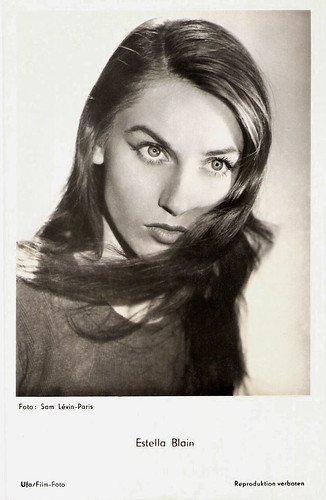
German postcard by Ufa, Berlin-Tempelhof, no. FK 1085. Photo: Sam Lévin, Paris.
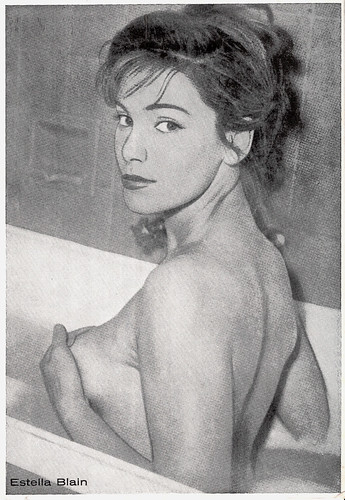
Vintage card.

East-German postcard by VEB Progress Filmvertrieb, Berlin, no. 2964, 1967. Photo: publicity still for Le fauve est lâché/The Beast Is Loose (Maurice Labro, 1959) with Estella Blain and Philippe Mareuil.
Trailer of The Diabolical Dr Z (1966). Source: Montag The Magician (YouTube).
Estella Blain sings Solitude (1968). Source: Orgasmo Sonoro (YouTube).
Sources: James Travers (French Films), Robert Firsching (AllMovie), DB du Monteil (IMDb), Jens Kofoed-Pihl (IMDb), Wikipedia (French) and IMDb.
This post was last updated on 31 May 2023.
You r looking so charming,sexy and cute.I like your all photos.
ReplyDeleteI have no word to say about ur beauty.
ReplyDeleteIt is not well known,but Estella Blain,as many young actresses from the sixties,recorded some songs,at least two EPs;The songs were average ,but the picture covers very beautiful.(mostly in collaboration with Alain Goraguer)
ReplyDelete